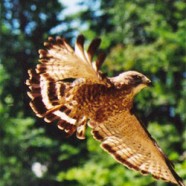
Problem/Background
Modern organophosphate insecticides are short-lived in the environment. These insecticides are toxic to raptors, but they are unlikely to be detected in animal blood or tissue unless the animals are sampled soon after exposure. Researchers postulate that pesticide exposures, and habitat alteration, in their wintering areas in Central and South America may be adversely affecting broad-winged hawk (Buteo platypterus, BWHA) populations, and those of other neotropical migrants. However, it is unknown whether broad-winged hawks concentrate in certain areas in their winter range and what specific biological threats they might be exposed to during this part of their annual cycle. Essentially, the extent to which conditions encountered in the winter range affect the populations that breed in North America is unknown. This is largely because very little is currently known about the wintering ecology of this small, forest-dwelling raptor.
The broad-winged hawk is a neotropical migrant that breeds in eastern and central North American forests and winters primarily from Southern Mexico south through Central America to northern South America (Bolivia and Northern Brazil), with small numbers wintering in southern Florida. Its population status is of concern due to the decline in numbers of birds encountered at some migration observation points since the 1970’s and in some areas of its breeding range in the Eastern United States. Information is available on the natural history of the broad-winged hawk in North America, but little is known of its wintering ecology. Within the continental United States, breeding numbers appear to be stable in some areas but decreasing in others. The Puerto Rican population is classified as Endangered, and these declines are attributed to habitat alterations. Similarly, in the Eastern United States, some areas have reported declines in BWHA associated with human development and alteration of woodlands.

Broad-winged hawk integrated radio tracking
Approach/Objectives
Earthspan’s broad-winged hawk research focused on identifying critical habitat during the breeding season, along migration pathways, and during the boreal winter period. The approach integrated radio tracking via satellite, field monitoring, remote sensing, and a geographical information system (GIS) to identify locations and important landscape and nest site features used by the species. This study filled gaps in knowledge concerning aspects of broad-winged hawk migration and wintering biology and provided data critical for the development of a management plan for broad-winged hawks on federal, state, and private lands throughout its annual range.

Broad-winged hawk
Results
Because broad-winged hawks tend to travel in large flocks that are easily identified on NEXRAD radar imagery, Earthspan and the Clemson University Radar Ornithology Laboratory are attempting – for the first time ever – to correlate migration data of individual BWHAs with flock activity. Results from this study will be useful in the development of an effective resource management strategy for this species that can be applied throughout the Americas. Additionally, information collected about land use practices and environmental contaminant uses will be relevant to the conservation of a variety of other wildlife species.
Earthspan tracked (via satellite) broad-winged hawks from North America to their wintering areas and described important land cover types at the hawks’ destinations (both breeding and wintering). Our research provided information on the extent to which North American nesting populations associate with natural and modified habitats across the non-breeding range. Additionally, information may be acquired to describe their exposure to habitat alteration and environmental contaminants in their wintering areas. The breeding habitat, migratory pathways, and wintering range of broad-winged hawks are also shared by a number of other neotropical migrant species, including several that are species of major conservation concern. This project will set the standard for other research projects to study the movements, migration, and wintering habitats of other neotropical migratory species.
Resulsts from this project were published in The Wilson Quarterly.

Broa-winged hawk tracking map
